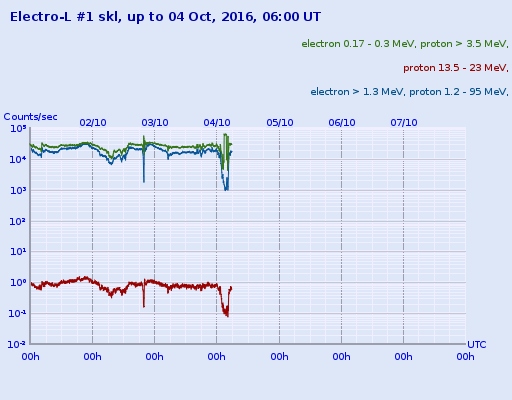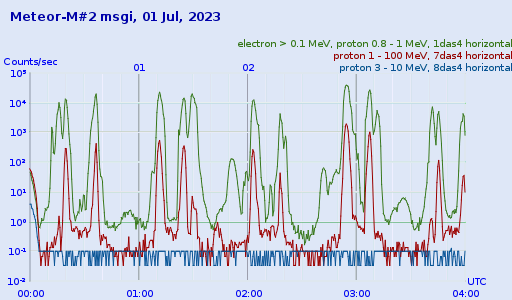 Coronal holes
Coronal holes

Recurrent high-speed solar wind streams (HSSWS) are one of the manifestations of solar activity. HSSWS are responsible for the moderate geomagnetic disturbances in all phases of the solar cycle. The source of the HSSWS are coronal holes (CHs) which appear as regions of decreased intensity in the ultraviolet and X-ray solar images due to low coronal plasma density and temperature.
The figure on the left shows the current image of the Sun provided by Atmospheric Imaging Assembly (AIA) instrument on the board of the Solar Dynamics Observatory (SDO) at a wavelength of 193 ?. CHs are highlighted with white contours on this image.
Parameters and location CHs are calculated based on automatic image analysis algorithm. Estimated CH parameters are used to forecast the value of SW velocity using various linear and non-linear methods. The "Space Weather" section shows images of the Sun at different wavelengths, as well as solar wind velocity forecast near the libration point L1.
|
 Magnetosphere today
Magnetosphere today
Магнитосфера Земли является результатом постоянного и активного взаимодействия
между сверхзвуковым потоком замагниченной, полностью ионизованной плазмы, истекающей из солнечной короны, и собственным
магнитным полем Земли. В ходе такого взаимодействия формируются головная ударная волна, магнитопауза и магнитосферные
токовые системы. Крупномасштабные токи в магнитосфере Земли определяют структуру магнитного поля и, следовательно, размер
и положение плазменных образований в околоземном космическом пространстве, движение энергичных заряженных частиц.
Магнитосфера Земли и солнечный ветер находятся в постоянной взаимосвязи и представляют собой единую систему. Находясь
под постоянным воздействием солнечного ветра, магнитосфера Земли отображает вариации параметров межпланетной среды,
связанные, как, с активными, так и с циклическими процессами на Солнце. Наиболее ярким проявлением такого воздействия
являются взрывные процессы в магнитосфере: магнитосферные суббури и магнитные бури, приводящие к значительному
энерговыделению во внутренней магнитосфере. Наряду с этим, эффекты вращения Солнца, одиннадцатилетнего цикла солнечной
активности, также уверенно регистрируются по состоянию магнитосферы, по вариациям магнитосферного магнитного поля.
Структура магнитного поля (рисунок справа) дает специалистам представление о процессах,
происходящих в магнитосфере Земли. Получить подобную структуру помагают численные модели магнитосферного магнитного поля,
которые по данным измерений, основываясь на теоретических предположениях, позволяют построить катрину магнитного поля во
всей магнитосфере. Вместе с измерениями на космических аппаратах (КА) это позволяет проводить полноценные научные исследования
и строить прогнозы космической погоды. Watch magnetosphere in 3D
|
 Expert's comment
Expert's comment

Sun-Earth relations are the system of direct or indirect physical relations between helio- and geophysical processes. On-line monitoring of space weather is the continuous tracking of variations of conditions in the near-Earth space and of geoeffective phenomena causing them. ?Geoeffective events? in solar and terrestrial physics are events directly influencing the radiation, geomagnetic and electromagnetic situation in the near-Earth space.
The main manifestations of solar activity which can become the reason of geoeffective events in the near-Earth space are flares and coronal mass ejections (CME). Besides that, the other reasons of disturbances in the near-Earth space are high-speed streams of solar wind reaching the Earth's magnetosphere. Their sources are coronal holes existing at the Sun.
Comments of an expert about current conditions in the near-Earth space can be followed in the space weather blog.
|
 Current Data from Russian Satellites
Current Data from Russian Satellites
|
The figure at the right presents current measurements of energetic charged particle fluxes at geostationary orbit obtained by satellite "Elektro-L1". "Elektro-L1" satellite is Russian hydrometeorological spacecraft launched on January 20, 2011 to the geostationary orbit (perigee ? 32000 km; apogee ? 32100 km; longitude ? 76њ; latitude ? 0њ). Green and blue curves show the variations of the flux of subrelativistic and relativistic electrons in the outer radiation belt of Earth (and also small additional flux of solar cosmic rays). The red curve characterizes the flux of solar protons at the geostationary orbit.
|
|
The figure at the left presents the flux of energetic charged particles measured in the polar caps onboard the artificial satellite "Meteor-M2". The artificial satellite "Meteor-M2" is a Russian hydrometeorological spacecraft launched in July 2014 to the circular polar orbit (altitude 825 km, inclination 98.8њ). Color lines show the average variations of flux of energetic charged particles, measured by the SCR device.
|
|
 Data Bases Data Bases
The space monitoring data base contains measurements of domestic satellites since 1983.
Coronas-I, Coronas-F, Cosmos-1686, Prognoz-9, Coronas-Foton, Meteor-3M, Mir space station (Rabin's and Griff's experiments), Tatjana, Tatjana-2 - here's a list of spacecrafts which have completed their mission and whose data is stored in the space monitoring data base.
Now the data base continues to be filled up in line with the operational satellites connection timetable(Meteor-M ?1, Electro-L ?1).
The relevant data from operational satellites can be accessed directly from this page.
The satellite "Lomonosov", developed at the Moscow State University, is planed to be launched in the near future.
|
 Models Models
Models are the main tool to perform an analysis of the current state of the space environment or to provide prognostic short- or long-term report on the state of the space. Models summarize the obtained empirical data and reproduce the structure of the magnetospheric domains and the dynamical proccesses in the magnetosphere.
Using as input the measurements made at fixed locations for a limited time, by the ground support environment and satellites, models provide additional information about the state of the space environment in the regions of space where measurements were not performed.Using as input the measurements made at fixed locations for a limited time, by the ground support environment and satellites, models provide additional information about the state of the space environment in the regions of space where measurements were not performed.
Conducting an experimental research (for practical use in scientific and applied research) engineer versions of five models of various factors of the space environment are used:
|









 Coronal holes
Coronal holes  Magnetosphere today
Magnetosphere today  Expert's comment
Expert's comment 
 Current Data from Russian Satellites
Current Data from Russian Satellites 

 Data Bases
Data Bases